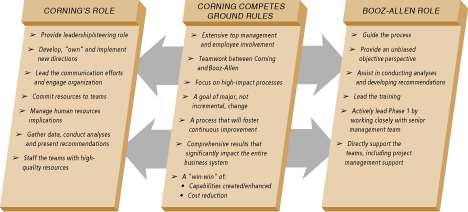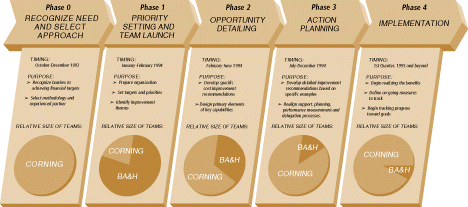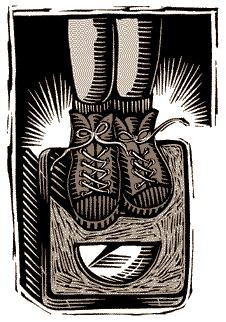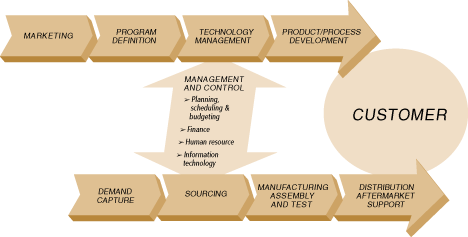Partnering for Results: A Case Study of Re-engineering, the Corning Way
How do you institute real change while preserving a company's culture? Corning Incorporated did it by starting at the top and by creating a partnership to transform itself through a comprehensive reassessment of its existing costs and hopes for growth.
How objectives were set and decisions made in a major re-engineering program that produced dramatic results for Corning Inc., a company that has been a world leader for many years in specialty glass materials. Telling this story are Gary Neilson, a vice president of Booz-Allen and the leader of the firm’s global Operations Management Practice, and Roger G. Ackerman, who is Corning’s chairman and chief executive officer. At the time this program was implemented, Mr. Ackerman was president and chief operating officer at Corning.
As frequently happens with large corporations, it took an unexpected shock to drive Corning to a serious self-examination. The shock was a $15 million net loss, reported in late 1993, resulting from a one-time write-down of its equity in Dow Corning that stemmed from legal issues associated with silicone breast implants. More significantly, the company’s valuation in the stock market sank 25 percent. Corning’s response was to re-engineer but, for special and understandable reasons, to re-engineer with a difference.
For a start, Corning Inc. was long on tradition. The company was founded in 1851 in Massachusetts and moved to tiny Corning, NY, in 1868. As Corning Glass Works, it flourished and Corning, NY, became a company town. This became a sensitive problem in 1994, because more than half of the 12,000 residents were employees and a typical re-engineering effort would have spelled disaster for the community. Together, Corning Inc. and Booz-Allen created Corning Competes - a program that aimed at substantially reducing costs and producing profitable growth but at the same time remained sensitive to the community.
How Corning speeded up its decision-making, created a cost-conscious environment and encouraged the horizontal flow of information across the organization, is carefully described in the “phased” approach used by the joint Booz-Allen and Corning implementation teams. For a company with a company town culture, this was indeed a breakthrough to the future.
Leaders of successful corporations are always on the lookout for ways to improve their company's overall performance. In the past, cost-cutting and right-sizing were high on the C.E.O.'s agenda. Today, there is intense interest in innovation and revenue growth. To achieve the desired gains in shareholder value, corporate leaders often end up selecting from a menu of transformation options that address both costs and capabilities, including the popular methodologies of business process re-engineering.
The trouble is, these options, however powerful they might appear, regularly fail to deliver results because they are implemented on a piecemeal basis. Though some elements in a company's performance equation may show gains, the overall outcomes are less than optimal. A common theme among companies that have re-engineered is that while costs may have come down, there is concern about the ability to drive future growth through innovation. In fact, according to Michael Hammer, one of the founders of the re-engineering discipline, more than 70 percent of transformation projects at large companies fail to achieve their desired results.
This was a problem that the leadership team at Corning Incorporated did not want to encounter as it began thinking about the need to examine the company's cost structure and competitive capabilities in the fast-changing markets in which it participates--telecommunications, life sciences, consumer housewares and components for original equipment manufacturers. As a place to begin, the team refrained from looking at the company as a collection of discrete functions. Instead, it decided to transform Corning by taking a comprehensive, integrated approach to the company's cost structure and growth aspirations. The methods that were used were drawn from a re-engineering tool kit and were arrived at while working in partnership with Booz-Allen & Hamilton.
RE-ENGINEERING RE-ENGINEERING
Corning has a long history of partnering with outside companies to drive change. Prior ventures with Siemens and Samsung, among others, focused on leveraging Corning's core skills in materials science to enter new markets (telecommunications and display products, respectively). In most cases, this model has proven quite successful. Since Jamie Houghton took over as C.E.O. in 1983, Corning's stock split three times, driven by growth in the optical fiber business and an expansion into the fast-growing clinical testing business. This time, however, the nature of change was fundamentally different. Increased competition in the optical cable business, the growth of managed-care providers driving down prices in the medical testing market and the entry of low-cost foreign competitors into the long-stable housewares market all highlighted the need to challenge existing business models. As a result, management identified the need to move quickly beyond a strategy of relying upon breakthrough new products and growth markets to one that also emphasized value, speed and customer satisfaction.
In late 1993, these issues were brought to the forefront when Corning posted flat operating earnings and a net loss of $15 million, driven by a one-time write-down of its equity in Dow Corning related to legal issues associated with breast implants. This marked the first time in nine years that Corning had failed to meet its earnings targets. The market responded by reducing its valuation of Corning by 25 percent. This drove management to commit to establishing a program to produce significant improvements in performance across the company. As a result, management decided to undergo a structured re-engineering process to enhance Corning's competitive position, and ultimately shareholder value. Its goal was to reduce operating costs by some $450 million over three years while creating the right capabilities to drive profitable growth.

Illustration by Evangelia Philippidis
While Corning management realized the need to take an integrated approach to transformation, it also recognized the necessity of working within the context of the company's environment. Since more than half of the 12,000 residents of the company's home town of Corning, N.Y., are its employees, a massive effort to reduce costs would have been disastrous to the community. Working with Booz-Allen, Corning established the platform of Corning Competes, avoiding the "R" word (re-engineering) and its negative "downsizing" connotations. The Corning Competes label gave management the vehicle to define Corning's purpose--preparing for growth and recognizing the need to deal with costs, but also being sensitive to the community. And community sensitivity is an issue, according to Mr. Houghton, who notes that Corning is "the biggest company in the smallest town in the United States" (The Economist, Sept. 9, 1995). Corning thus developed its own brand of re-engineering, one that made the human and community elements important considerations in how the goal was to be achieved.
WALK THE TALK, AND TALK A LOT
To achieve its goals, management recognized that Corning's culture could use its own dose of re-engineering. In the past, visitors to the Corning valley would describe a paternalistic, functionally driven and risk-averse environment. Employees valued consensus; in the words of Jamie Houghton, people were "polite, and averse to confrontation." Kirk Gregg, vice president for executive resources and employee benefits, agreed, noting that "we spent a lot of time gaining consensus...we needed fewer committees, and more conviction." If Corning was to react faster to market and customer needs, management would have to speed decision making, create a cost-conscious environment and encourage the horizontal flow of information across the organization.
EXHIBIT I
"CORNING COMPETES" PARTNERSHIP STRUCTURE 
Corning did not want to turn the effort over to a consultant, but wanted a true partnership in driving change.
Not unique to Corning, however, was the issue of how to drive this change in the absence of a crisis situation. Ken Freeman, who was executive vice president for administration in 1994, put the problem this way: "We're trying to halt slow erosion, so it is hard for everyone to see the need for change." But change they did. Today there is a broad awareness of the need to manage costs and a renewed sense of urgency among the work force. Teams focus on continually improving process efficiency and effectiveness, and span the businesses identifying and communicating best practices. Says Norm Garrity, president of Corning Technologies, "As a result of the process, we move more quickly--today it is a different ballgame." While cultural change requires an ongoing focus, the Competes process greatly accelerated the institutionalization of new behaviors across the organization.
This change did not come easily, however. "You learn to get used to the things that constrain you--you just live with it," noted Bob Hoover, who was corporate director of manufacturing improvement in 1995. "This was our chance to change that behavior."
Early in the Competes process, management recognized that effective communication was essential for driving cultural change. Going after the hearts and minds of Corning's vital constituencies--employees, suppliers and customers--involved everything from town meetings and monthly Corning Competes bulletins to focus groups, surveys and the establishment of a 1-800 line. The goal of this communications process was to reach every employee on a regular basis with a consistent message. There was a focus on building in a feedback loop, so employees could express issues and anxieties about the process. This resulted in "Headlines in a Hurry," an electronic message center that responded to employee questions, typically within 72 hours. Senior management was heavily involved throughout the process, clearly demonstrating that change started at the top of the organization. This effort was geared toward defining the new vision for Corning, and promoting its acceptance.
AN ENGAGING PROCESS
When the first Competes teams were established in January 1994, their mission was to engage the organization and challenge it to seek new ways of conducting business. They took a process-focused approach, examining processes that cut across the organization, delivered high value to customers and offered significant opportunity for improvement. This effort was driven by key Corning personnel who were pulled out of the organization, and assigned to Competes teams on a full-time basis in what became known as the "Donut Factory" approach (so named for an off-site team room located next door to a Dunkin' Donuts on Main Street in Corning). As businesses were initially reluctant to surrender their crack troops, this approach was first met with resistance. However, eventually Booz-Allen convinced Corning that it needed to get many of its best people working full time to develop the program.
EXHIBIT II
"CORNING COMPETES" PHASES 
Using an analytical, hypothesis-driven approach, the Phase 1 teams scanned the entire enterprise to find opportunities for improvement that would have the highest impact. When the results of the team's analyses became available, some of their findings were quite unexpected in terms of the magnitude of untapped potential. "One of our biggest surprises was the potential in manufacturing--we had always prided ourselves on what we were achieving in this area...but we put it on the list of areas to look at," a senior executive said. The teams determined that the other high-impact opportunities were in innovation, purchasing, and business and corporate roles (internal management practices).
After the opportunities were identified, follow-up teams were established to drive the process forward. Moving from Phase 2 to Phase 3 involved the development of specific and quantifiable improvement opportunities and the preparation of implementation plans. Phase 4, the final step, was to implement and track results, a process that is now well under way. According to Frank Jones, one of the Booz-Allen vice presidents working on the program, "Here the challenge was to insure that the process-focused ideas and recommendations were effectively owned and handed off to the line organizations." In all, the Competes process involved more than 300 people from the entire organization, from the boardroom to the shop floor. "We have been able to examine every aspect of the way we conduct business from top to bottom...it is a process we'll use over and over again and it has changed the way we work," a senior executive said.
The ability of the teams to drive change was due to several unique aspects of their re-engineering tool kit, including:
- Top management's involvement and commitment
- Strong analytical content
- Structured communication process that focused on sharing information across the organization
- Rigorous, results-oriented program management
- Stretch goals in terms of both cost and capability
- Extensive training
These elements appealed to Corning's management team for several reasons. First, as the recommendations were driven by an analytical examination of the data, and would be based on facts, not opinions, they would be more readily accepted by the organization. In addition, the results would be easier to quantify (and measure) as both cost and capability base lines would be developed for each process. According to Jim Ramich, executive vice president for the information display group, balancing the goals as "half cost and half capability enhancement" would insure that the organization was ready to address its cost position in the short term, while building the capabilities to compete effectively in the long term. Extensive training with the B.P.R. methodology enhanced the "human capital" of the organization, insuring that re-engineering could continue on a smaller scale in the future. All of this was tied together in the development of an approach to communications that built acceptance of the effort, and laid the groundwork for cultural change.
WE SHALL OVERCOME
Even with their well-structured approach and deep tool kit, the teams were bound to face barriers to change. Some of these surfaced at the beginning of Phase 4, as team leaders exhibited a natural tendency to want to "declare victory" and move on. From their perspective, the major issues had been identified, process redesigns were completed and the benefits of the changes were quantified. But without a continued focus on implementing the re-engineered processes, the benefits would materialize only slowly, if at all. To overcome this common implementation hurdle, the team leaders were asked to construct "the wall," a detailed map of all the initiatives, their impact by location and time frame and who was responsible for their implementation. The use of visual cues, like color coding, immediately focused attention on initiatives that were not progressing as planned so that the appropriate actions could be taken. Team leaders knew that they were held accountable since the wall was regularly monitored by senior management.
While the use of the wall provided the incentives for team leaders to drive progress, there was also the need to build business buy-in of the changes. Though the team leaders had progressed through the process of developing hypotheses, gathering data and performing analyses, the company's operating businesses did not have the background on all of the details behind the changes. In addition, they had their own priorities to deal with.

Illustration by Evangelia Philippidis
To overcome resistance, senior managers recommended two approaches. First, they created the role of "sector implementor," to be filled by an individual from within the business who would be responsible for driving and tracking progress on each of the initiatives. Second, to help the businesses visualize the benefits, the teams publicized "quick hits" wherever possible. For example, the manufacturing team was able to cut variable costs while simultaneously achieving significant gains in available capacity by reducing complexity in one of the plants, by trimming the number of product variations and thus the number of times equipment had to be shut down for model changeovers. By communicating this success to the organization, the teams built momentum for change, increasing demand for their services company-wide.
Thus, by focusing on both team leaders and business buy-in, Corning management overcame the natural barriers to change that are the downfall of many re-engineering initiatives.
RESULTS EXCEED TARGETS
By engaging and challenging the enterprise, Corning has been able to achieve results that have exceeded goals in terms of both capabilities and cost reduction. Nearly every aspect of the business has experienced significant improvements in performance.
EXHIBIT III
ENTERPRISE

DELIVERY STREAM
One example of the benefits of the integrated approach taken by Competes comes from the purchasing organization. Corning had adopted a purchasing model designed around a group of experts in material categories who developed purchasing strategies and had, in fact, a strong track record of delivering year-on-year savings to the businesses. However, minimal linkages with the businesses resulted in strategies that were not well integrated with the business needs, leading to resistance in adopting the proposed approaches and to sub-optimal savings.
The approach adopted by the Competes teams involved locating senior buyers within key business units to improve two-way communication. This served to drive the businesses to agreement on budgeted savings for purchasing, and increased their "pull" to deliver results. Additionally, this approach reduced the level of transactional activity within purchasing, freeing up resources for strategy development and the rebuilding of purchasing management information systems. The Competes purchasing teams worked across all the businesses in this highly co-operative model to develop targeted purchasing strategies by commodity -- raw materials, supplies, services, energy, capital and purchased wares. To date, savings are flowing in at an impressive rate, and the targeted savings of $85 million (on an annual basis) is likely to be achieved one year ahead of schedule.
In the case of Competes, there were "no sacred cows." This was illustrated by the business and corporate roles team, which tackled the thorny issue of the role of the corporate center. Over the past decade, Corning had developed a model for its corporate functions that emphasized relatively high service levels and vertical integration. As a result, Corning built internal capabilities for services including lawn maintenance, benefits administration and food service. If Corning was to transform itself, it had to recognize that delivering corned beef sandwiches, while important, would not help it to compete against the likes of AT&T. With that in mind, the teams examined more than 50 corporate functions for opportunities for improvement.
To date, several services, including transportation and records management, have been outsourced, with several others in the later stages of the vendor selection process. Several other processes, including cafeteria services, have been redesigned to improve their efficiency. Overall, corporate staffing has been reduced by 600--through a combination of early retirement, attrition and targeted layoffs--with minimal impact on service levels and the community.
"People are getting used to the new staffing levels," said Van Campbell, vice chairman and chief financial officer. "There was some resistance at first, but people now recognize the need to challenge the status quo, and to address our cost position. It is the beginning of a culture change that was absolutely required."
The innovation process, long hailed as one of the hallmarks of Corning, was also examined by several Competes teams. Initially, the teams determined that a decline in revenue contribution from new products to 23 percent of sales in 1993, from 40 percent in 1990, was due to Corning's tendency to target high impact but low probability opportunities. (New products are defined as those introduced in the last five years.) "We tried to hit home runs, and did not focus on the singles, doubles and triples that built our business," said Dr. David Duke, a senior technology executive. In addition, one team determined that Corning spent too much of its R.&D. money in slow-growth markets, which generally produce a smaller payback.
As a result of their analyses, the teams identified and implemented several process improvements, including strengthening technology ownership at the business level and creating a rigorous yet flexible innovation process. They also built the capability to define the portfolio of innovation projects by risk and opportunity profile at both the business and corporate levels. While the changes are just now taking hold, it is clear that the redesigned processes are critical for Corning's growth aspirations. "This is a process we have waited 15 years for," a senior executive said.
These are a few of the results that came from focusing improvement efforts around several basic themes. From the start, teams were directed to identify best practices that existed within Corning, and to establish a process for sharing these practices across the company's businesses. With multiple businesses and plant locations across the world, which had operated fairly autonomously, this area provided fertile ground. Once these best practices were identified, the teams focused on simplifying and strengthening critical processes by taking a clean sheet approach to redesign to provide more rigor and better process definition. Another common improvement theme was the deployment of enhanced decision-support systems across the processes.
LESSONS FROM LEADERS
As is to be expected, all initiatives did not progress at the same pace across the organization. By examining those processes that were slower to take hold, the teams identified some common themes. The need for strong leadership and a full-time process champion to push progress was cited as one of the key drivers for the successful initiatives. "Leaders need to be actively engaged in the initiatives," said Mr. Garrity of Corning Technologies, "to ask questions, follow up, measure results and reward new behaviors." But involvement alone was not enough. The leaders of the successful initiatives demonstrated a passion for change, and a willingness to challenge the status quo. "They needed to sit on the desks of the business leaders," said Mr. Campbell, vice chairman, "and let them know that they will not go away until the changes are implemented." As is the case in companies, industries and governments, the ability to drive change often comes down to a simple yet resolutely (Abstract) concept--leadership

Illustration by Evangelia Philippidis
A more tangible issue identified by the teams involved the need for structured measuring systems. Monitoring and tracking were seen at first as burdensome and perhaps not really necessary, but later were deemed to be essential to facilitating implementation. While some process teams, such as purchasing, created a measurement system that was linked to Corning's financial systems, the overall Competes initiative did not drive an enterprise-wide cost and capability tracking system. One senior executive, Mr. Garrity, recognized this, and implemented a Lotus Notes-based system, which, he said, "allowed us to easily track progress against both capability and cost objectives, enabling us to integrate key milestones into division managers' variable compensation." The system contributed to the relatively high level of progress in his business unit, and is now being examined for deployment in other areas.
The teams also generated insights into what worked well for Corning--practices that will be built into the organization's ongoing methods of conducting business. The structured, full-time team approach was new to Corning, and was cited as a key success factor for the initiative. While meeting initial resistance, the philosophy of pulling some of the best people from the organization for a full-time assignment will become an ongoing practice for Corning. "There was real value in taking key players and having them hold a mirror to the organization as a means for driving change," Mr. Campbell said.
These teams worked in the same area, improving their ability to share information and facilitating the establishment of informal networks that continue to yield benefits. Driven by clear and aggressive goals and objectives at each step of the way, the teams were held accountable for identifying barriers to success and directing progress throughout the organization. As a result of this process, Corning management and employees have learned "the meaning of rigor, to listen and share thoughts and to be results-oriented...one of the best things we did was to send the teams to the Donut Factory," an executive said.
CORNING COMPETES
While Corning still faces challenges, the Competes program has significantly improved its competitive position. "In 1994, Corning's products businesses made $140 million, and we told analysts we planned to double this by 1996 with the help of Corning Competes. But in reality, we hit $310 million in 1995! By this time we were targeting $200 million in incremental savings and have shot right past that target in delivering," a senior executive said.

Illustration by Evangelia Philippidis
In addition, capabilities to drive growth are coming on-line. A globalization team has been developing processes to enable Corning to capitalize on emerging opportunities across the world. Through a new framework for global expansion, the team dismantled the old paradigm of the businesses pursuing opportunities in isolation by defining a mechanism for them to share risks and resources. As a result, Corning is now better able to leverage its diverse product portfolio to capture opportunities in emerging global markets--a key part of any growth strategy.
By taking an integrated approach to transformation, and addressing the necessary culture change within the context of its values and competitive situation, Corning management has delivered upon its commitment to customers, shareholders and employees. At the end of January 1996, Corning management held a Competes celebration for the 300-plus people who participated in the process. During the presentations, a senior executive made the following observation: "Corning Competes has had a profound impact on the future of this company. The renewed focus on rigorously defined, value-added processes will enable us to win on the competitive battlefield and achieve our financial objectives. The hundreds of fellow employees who gave so much of themselves in this effort have changed this company forever. We simply cannot thank them--you--enough."
THE LESSONS LEARNED
The Corning Competes program demonstrates that re-engineering can be an effective tool to address costs while simultaneously building the capabilities to drive growth.
As part of the company's desire to learn from the process, a team recently undertook a six-month review of Competes, with the intent of defining the processes that will drive continuous improvement and capturing the key lessons learned. As a result of the review, the team uncovered several universal factors that it believes drove the success of the Competes initiative:
- Senior management buy-in, and continued leadership and communication to all levels of the organization.
- A true partnership with the outside firm to guide the process.
- A balance between cost and capability improvements.
- A framework for reaching goals developed within the context of the company's unique competitive situation, values and culture.
- Recommendations driven by fact-based analyses.
These factors, combined with a willingness and a courage to accept change, allowed Corning to succeed in its aim to significantly enhance its competitive position.
KEYS TO INSTITUTIONALIZING CHANGE
How Corning is organizing to hold on to the gains made during the Competes program:
- Formalizing process-steering committees that have responsibility for sharing best practices and driving continuous improvement on an enterprise-wide process level.
- Establishing a small re-engineering "Center of Excellence" to insure that skills are retained and used to deliver value.
- Deploying measurement systems that support the identification of best practices and continuous process improvement.
- Continuing communication by senior management to reinforce new behaviors.

Reprint No. 96205


